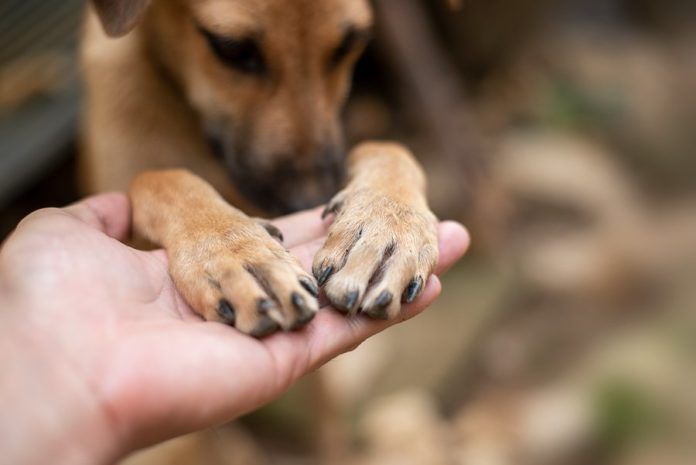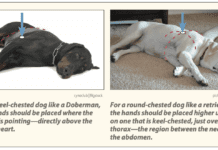© beginos | Bigstock


“A number of the surgeries I perform involve removing tumors from dogs’ feet,” says John Berg, DVM, a soft tissue surgeon at the Tufts Cummings School and the editor-in-chief of Your Dog. Likewise, veterinary dermatologists often say that the feet are among the main areas where dogs are affected by allergies. Lots of diseases strike the foot pads also: liver disease, some autoimmune diseases, even an illness that hinders blood flow to the foot. Another way of putting it: a dog’s feet can carry a heavy load.
Here’s a look at some of the illnesses that keep dogs from putting their best feet forward, with guidelines for recognizing and treating them.
Allergies
Why would allergies be more apt to strike through a dog’s feet than other parts of her body? Simple. The feet have less hair than other areas, making it easier for environmental allergens — pollen, dust, mites, and mold — to make their way through the feet’s sparse coat and into the skin. The same can be said for other parts of a dog’s body with a sparse coat — the ears, under the arms, and the groin.
But the feet may be the most vulnerable area of all. The areas between the digits are tight spaces where a lot of moisture can get trapped. Add to that the extra heat between a dog’s toes, especially in the presence of an allergen that causes inflammation and tightens the spaces even more. The moisture-heat combo makes the feet ripe for infections secondary to the allergies themselves. These infections can be bacterial in nature or due to yeast. Either way, these secondary infections can cause areas of skin damage that only serve to exacerbate the allergy problem. And, of course, since a dog can easily get at her toes, a dog who feels uncomfortable or itchy because of her allergies will lick or chew her feet, making the inflammation that much worse and upping the vicious cycle.
What will all this look like to you? You might see some swelling, redness, or discharge — a rusty color between the toes that results from salivary staining. It’s not blood, even though it might be mistaken for blood. It’s just a reaction that occurs when compounds in saliva are oxidized. Think: rusting. (It can be particularly noticeable if your dog is white or blonde.) Skin damage, on the other hand, can be subtle, which is why it’s a good idea for the veterinarian to take a close look at your dog’s feet as part of her wellness exam.
If allergies are diagnosed, the vet will go on to determine whether they are environmental allergies or allergies to particular food ingredients. Almost every time it will be environmental allergies, which affect 10 percent of dogs. Food allergies are extremely rare, despite all the talk about them on the Internet.
Medications for environmental allergens include steroids (to reduce inflammation during flare-ups); perhaps cyclosporine to suppress the overactive immune system causing the symptoms; and allergy shots. Frequent bathing with a moisturizing shampoo may also be recommended to remove the accumulation of allergens on a dog’s coat.
If a secondary infection develops because of an allergy, antibiotics will be prescribed if the infection is bacterial; anti-fungal medications if the cause of the infection is a fungus.
Illnesses that hit the footpads
While allergies tend to show up on the feet and toes, and between the toes, some conditions break out on a dog’s footpads — those black shock absorbers under the toes that are kind of the equivalent of palms. Because dogs don’t wear shoes, a problem with the footpads can create real problems with their ability to walk properly, as well as make them uncomfortable. Depending on the illness, the pads can either thicken or erode. Either way, it’s not what you want. Moreover, diseases of the footpads tend to be more concerning than allergies because they can be a sign of internal disease. The footpads are the “messenger” rather than the endpoint of the problem.
Three conditions that are signaled by the footpads are on veterinary dermatologists’ radar:
Pemphigus Foliaceus. One of the most common autoimmune diseases dogs get, pemphigus foliaceus involves the immune system attacking the proteins that hold a dog’s skin cells together. As a result, the skin cells spread apart from each other, and little pustules form on the surface of the foot pads.
You cannot see the pustules, only the crust that develops on the footpads because the dog is constantly walking. The pressure of the footsteps breaks open the pustules as they form. The condition is not only painful. It also leaves a dog open to secondary infections. Once the skin barrier is broken, pathogens can migrate into the body.
Diagnosis of pemphigus foliaceus entails a biopsy, either with sedation and a local anesthetic or with general anesthesia. When the diagnosis is confirmed, immune-suppressing drugs are prescribed. After the flare has calmed down, the prescription is reduced to a maintenance dosage that the dog remains on for life. At the lower dose, the medications work more as anti-inflammatories than immune suppressants.
Hepatocutaneous Syndrome. Whenever you see the root “hepa” in a medical term, it means the condition pertains to the liver, coming from the Greek word for that organ, hepatos. This illness is no different. Hepatocutaneous syndrome, characterized by a thickening of the footpads, means something is wrong with the liver — specifically, that it’s not utilizing proteins the way it’s supposed to. Normally, the liver breaks down proteins into amino acids, after which they are recombined to create new proteins as needed. Some of the proteins help build skin. But in the case of hepatocutaneous syndrome, a number of amino acids are significantly reduced in circulation. Lesions on the footpads are one of the first signs, often occurring long before a dog would start to feel sick because the liver is not doing its job right.
Diagnosis includes a blood draw to check liver enzymes; if the numbers are off, the vet knows the liver is not working properly. An ultrasound is often included in the workup, too. Rarely, it’s not the liver causing the problem but the pancreas, which secretes hormones critical for protein breakdown and re-synthesis. Whichever of the two organs is responsible for the illness, its etiology is idiopathic, meaning the cause is unknown.
That means doctors can’t get at the root of the problem, and the prognosis is very poor. Treatment consists of giving the dog amino acids intravenously and sometimes supplemental protein powders in an effort to provide the body with the right proportions of amino acids. But even with that, dogs live only about six months after diagnosis, on average. They can be kept comfortable during their decline by treating any secondary bacterial or fungal infections that result from breaks in the compromised skin of the footpads.
Ischemic Dermatopathy. This is an illness in which blood flow to the skin is compromised. The result is erosions or ulcers in the central portion of the footpad. It can be the pad for any of the digits or the central footpad. The lesions are very circular, almost as if someone took a hole punch to the affected pad.
As with hepatocutaneous syndrome, the cause is unknown, although in some cases it has been linked to the rabies vaccine. Whatever the reason for this disease, it is extremely uncommon. A veterinary dermatologist might run across a case once every few months.
A biopsy to diagnose ischemic dermatopathy is usually not necessary because the disease is so visually distinct. Treatment consists, at first, of steroids to help reduce pain and inflammation. Over the long term, a drug called pentoxifylline will often be prescribed. It, too, has anti-inflammatory properties, but more importantly, it makes a dog’s red blood cells very flexible, or bendable. That lets them change their shape in order to make their way into all the little blood vessels that have been damaged and therefore are not letting blood flow to the skin. In so doing, the little circular erosions gets filled in.
Because of the rabies vaccine link for some dogs, owners are told that their pet is not a good candidate for that inoculation. If a state permits a waiver on the vaccine, there’s no issue. If it doesn’t, the dog prophylactically receives a maintenance dosage of medication for ischemic dermatopathy. She’s on the maintenance dosage essentially for life, and about a month before the rabies vaccine is administered, the dosage is increased.
Tumors
Even if a tumor on a dog’s foot is benign rather than cancerous, it usually needs to be removed for a dog to continue to be able to get around easily, Dr. Berg says. If it is cancerous, or malignant, meaning it has the ability to spread and/or invade local tissues, it’s often squamous cell carcinoma.
Carcinomas are cancers that arise from epithelial tissue, including tissue that comprises various body linings, including the skin. Squamous cell carcinomas can also begin in the bone of a dog’s toe that houses the nail bed. Each toe has three bones, just like a person’s toes or fingers, and the nail bed is always located in the bone closest to the nail. That bone is called p3.
Standard poodles have a particular tendency to get squamous cell carcinoma of the nail bed, particularly black ones. But no dog is immune. If you have a dog whose nail falls out without any trauma to the spot, you should be suspicious and take her to the veterinarian, Dr. Berg says. Fortunately, squamous cell carcinomas don’t tend to metastasize, that is, spread, so they have a good prognosis once the affected toe is amputated.
Sometimes the cancer affects multiple digits on different feet, not because it has spread but simply because it has arisen in a number of spots. In such a case, the doctor may recommend removing the p3 bone in every single digit. If you remove the bone and save the digit from potential cancer, the dog won’t ever be in the predicament of not being able to walk because he no longer has any toes.
Along with squamous cell carcinoma, other cancers that affect dogs’ feet include melanomas of the digit; mast cell tumors (originating in the skin or the subcutaneous fat just under the skin); soft tissue sarcomas (sarcomas arise from connective tissue like nerves, muscles, and tendons); and osteosarcoma, or bone cancer. They’re all potentially difficult to remove surgically unless the tumor is very small or confined to a toe. That’s because, as Dr. Berg explains, “there’s not much skin on the foot. Because it’s tight, you can’t easily do a wide incision, cut away the tumor, then close the incision.”
Tumors located in a toe can be treated by toe amputation, and generally are not as problematic as tumors elsewhere on the foot. It may sound drastic, but a dog can function extremely well without a toe. In fact, once the incision heals, the gait will be perfectly normal. Even dogs who lose two toes will return to normal function, Dr. Berg says, although it may take a little longer — up to a few weeks – and there may be some very mild residual lameness. That’s certainly a much better option than letting a tumor get out of control to the point that the only solution is to amputate a leg.
Trauma
Foot problems for dogs are not always about an illness or allergy. Like us, their feet can be traumatized in accidents or by severe burns. If the big central foot pad is involved, it may not be possible to remove it because that makes it much more difficult to bear weight on that foot.
Sometimes, Dr. Berg says, “we’re able to remove pad tissue from one or two of the toes and use it to replace the tissue of the central foot pad. This is only necessary when a dog loses more than about a third of the foot pad,” he notes. “Otherwise, the dog simply won’t be able to walk or run properly.”
Sometimes, the solution to foot trauma is much simpler. If there’s a laceration, it can be sutured. Fractures can sometimes be fixed as well. A fractured toe will tend to get amputated because it’s too complicated, not to mention expensive, to reset the bone for healing, and the dog will be able to get about with just one missing toe on a foot. But if other bones in the foot are fractured, there are procedures to reset the bone and give the dog full use of the limb.





